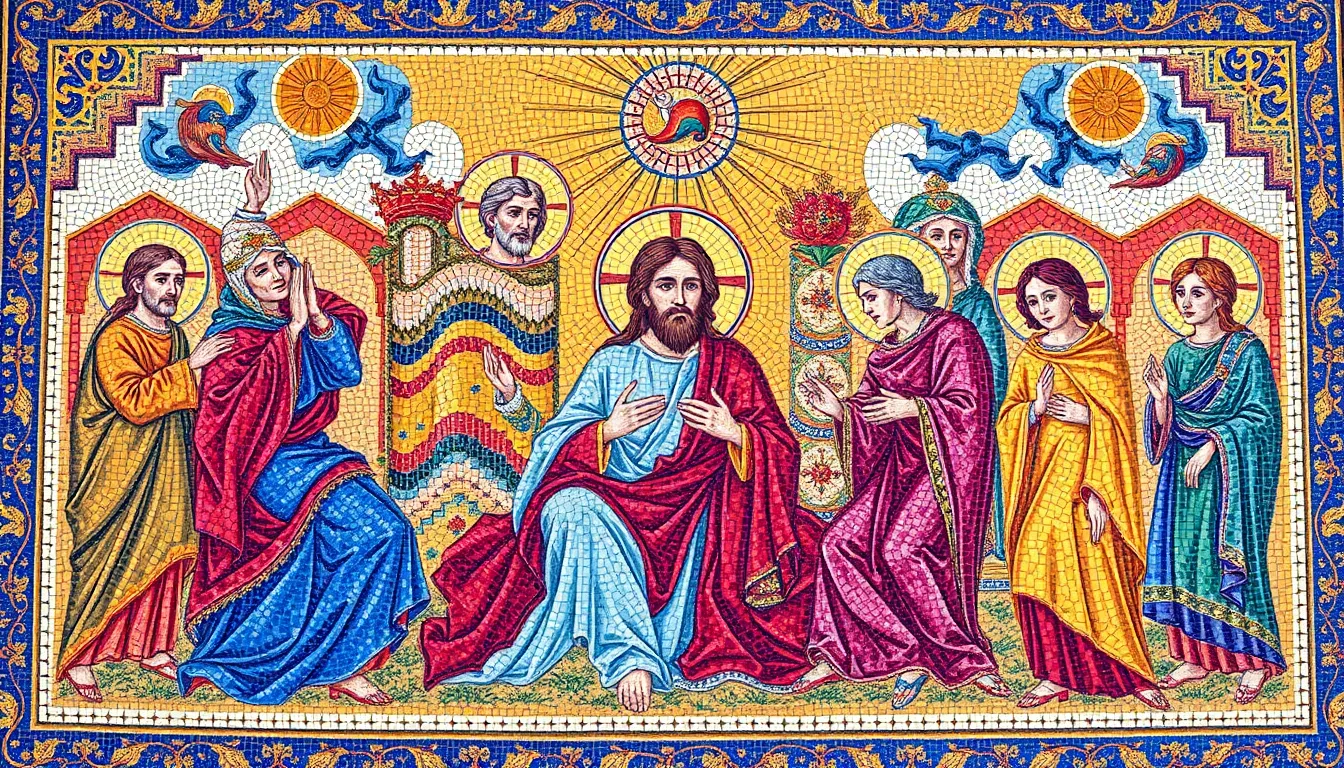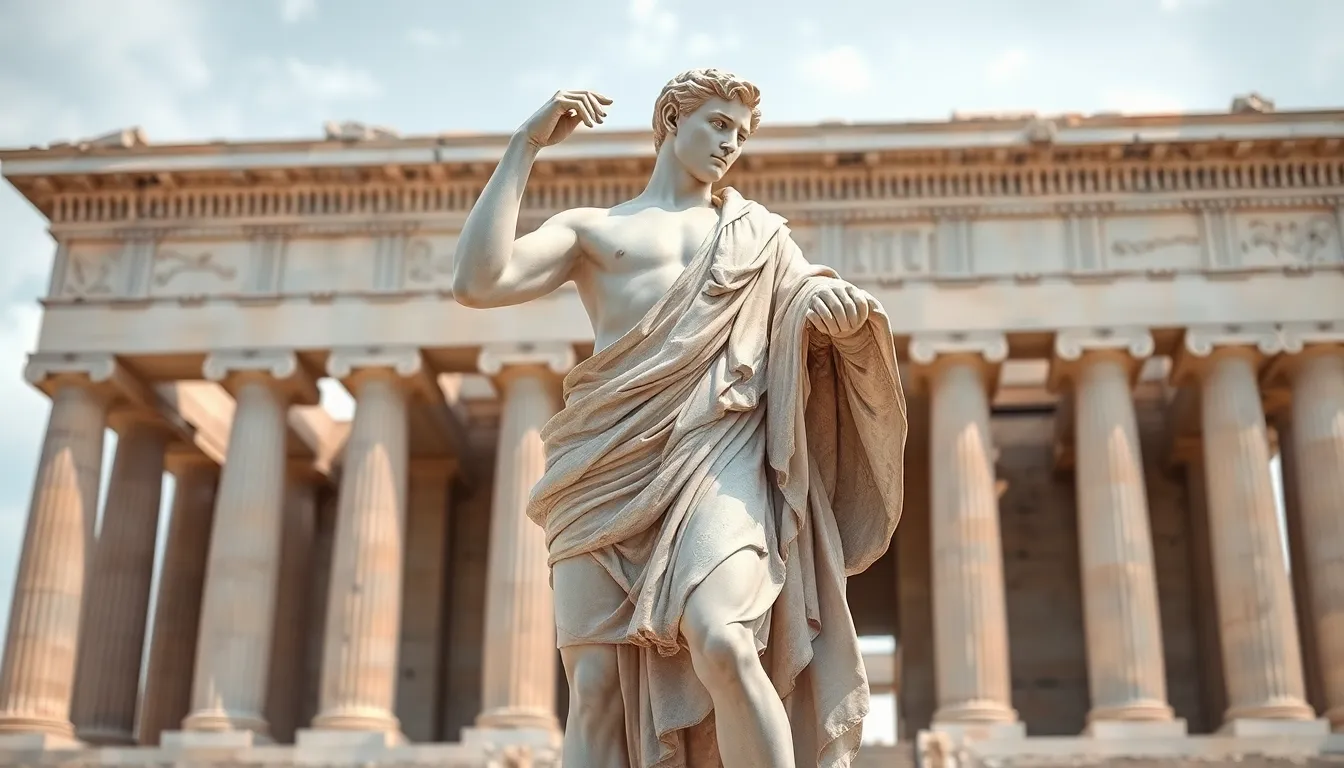Classical Christian art isn’t just a collection of old paintings; it’s a vibrant tapestry woven with faith, history, and a dash of divine inspiration. Imagine stepping into a time machine where every brushstroke tells a story of devotion, struggle, and the occasional heavenly intervention. From the ethereal beauty of Byzantine mosaics to the dramatic flair of Renaissance masterpieces, this art form captivates the soul and tickles the imagination.
But let’s not forget the humor behind the halos! These works often reflect the quirks of their time, blending piety with a sprinkle of personality. Whether it’s a saint sporting an unexpected expression or a biblical scene that raises an eyebrow, classical Christian art invites us to see the divine with a wink. Dive in and discover how these timeless creations continue to inspire and amuse, proving that faith and artistry go hand in hand—sometimes with a chuckle or two.
Table of Contents
ToggleOverview of Classical Christian Art
Classical Christian art represents a profound synthesis of spirituality and creativity, often reflecting theological beliefs and historical contexts. This art form emerged in the early centuries of Christianity and evolved through various styles, including Byzantine, Romanesque, and Gothic influences.
Byzantine art stands out for its intricate mosaics and icons, which convey deep religious narratives. Mosaics in places like Hagia Sophia showcase vivid colors and gold leaf, capturing divine light and emphasizing the presence of God. Icons serve as windows to the divine, inviting worshippers to connect with sacred figures.
Romanesque art introduced a more monumental style, characterized by solid forms and a focus on storytelling through sculpture. Cathedrals adorned with reliefs depicted biblical scenes, guiding the faithful’s understanding of scripture. These artworks functioned as visual sermons, making complex theological concepts more accessible.
Gothic art further transformed the landscape with greater naturalism and use of light. Stained glass windows in cathedrals like Chartres illuminate interiors with color and narrative. Artists employed light to evoke spiritual experiences, guiding the viewer’s gaze toward heavenly themes.
Renaissance artists rejuvenated classical principles, merging humanism with Christian themes. Notable works by figures such as Michelangelo and Raphael reflect this shift, blending divine elements with human emotion. Their masterpieces invite viewers to explore the interplay between humanity and divinity.
Overall, classical Christian art combines various styles and techniques, each adding depth to its rich narrative tradition. Artists across centuries have contributed to this dynamic dialogue between faith and creativity, continuing to inspire and engage audiences around the world.
Historical Context

Classical Christian art developed through distinct historical phases, reflecting evolving theological concepts and cultural influences. This rich heritage encompasses significant trends spanning centuries.
Early Church Influences
Early Christian art emerged during the Roman Empire, responding to growing needs for visual representation of faith. Christians adopted symbols like the fish and the Chi-Rho, conveying spiritual significance in a covert manner. The catacombs in Rome served as early venues for this art, housing frescoes and inscriptions that narrated biblical stories. Artists aimed to convey messages of hope using simplicity and accessible imagery. This foundational period established a narrative approach, allowing viewers to engage spiritually with the artwork’s themes.
Byzantine Contributions
Byzantine art represented a transformative period characterized by a unique fusion of religious devotion and artistic innovation. Mosaic techniques flourished, highlighting the use of vibrant colors and gold to create divine imagery. Iconography became a hallmark, emphasizing saints and Christ in expressive forms. Artists adhered to strict religious conventions, prioritizing spiritual truth over realistic representation. Architectural elements, like domes and arches, further enhanced the aesthetic experience within sacred spaces. These contributions solidified the cultural identity of Byzantine Christianity and influenced subsequent art movements across Europe.
Key Characteristics of Classical Christian Art
Classical Christian art features distinct traits that convey deep spiritual narratives. Central to its expression are iconography and symbolism, elements that allow artists to convey complex theological concepts through visual means.
Iconography and Symbolism
Iconography serves as a guide to understanding spiritual themes. Artists often used specific symbols like the lamb to represent Christ and the serpent to denote sin. These images invite viewers to grasp the underlying meanings, enhancing their spiritual connection. Sacred figures are depicted with halos to signify holiness, while colors are chosen for their symbolic value. For example, blue often denotes the divine and red symbolizes martyrdom. Each piece encourages reflection, revealing insights into faith and the human experience.
Use of Color and Composition
Color and composition play vital roles in classical Christian art. Artists strategically used a limited palette to evoke emotional responses and highlight important themes. Gold leaf frequently adorns backgrounds, symbolizing divine glory. Bright colors, such as reds and blues, draw attention to significant elements, guiding the viewer’s gaze. Symmetry and balance create harmony while directing focus toward key figures. Additionally, the arrangement of elements within a piece enhances the narrative, ensuring clarity in storytelling. Each decision in color and composition supports the artwork’s intended spiritual message.
Major Artists and Movements
Classical Christian art boasts a rich history defined by significant artists and transformative movements. Prominent figures propelled this art form, leaving lasting impacts on culture and spirituality.
Notable Works and Their Impact
Michelangelo’s The Last Judgment stands as a monumental example of merging divine themes with human emotion. Created between 1536 and 1541, this fresco adorns the altar wall of the Sistine Chapel, influencing countless artists and inspiring deep contemplation. Raphael’s The School of Athens, featuring classical philosophers, captures the synthesis of faith and reason, promoting the importance of intellectual pursuit within a spiritual context. Byzantine mosaics, like those in Hagia Sophia, exemplify intricate craftsmanship and religious narratives, shaping the visual language of Christian art for centuries. Each of these works contributes to an ongoing dialogue about divine representation, enhancing viewers’ faith and understanding.
Influence on Later Artistic Movements
Classical Christian art paved the way for several future artistic movements. The Renaissance, particularly, drew inspiration from the emotional depth and spirituality of earlier works. Artists like Caravaggio incorporated dramatic lighting and realism, bridging the gap between religious themes and human experience. Baroque art, emerging afterward, embraced ornate styles and emotional intensity, reflecting the subsequent Catholic Counter-Reformation’s needs. Romanticism later revived spiritual elements, emphasizing individual experience and nature as reflections of the divine. Each movement evolved from classical foundations, continuously reinterpreting themes and styles while engaging audiences with spiritual insights.
Classical Christian art stands as a testament to the enduring relationship between faith and creativity. Its ability to convey profound spiritual narratives through various styles showcases the richness of human expression in the context of divine inspiration. Each period brought unique characteristics that not only reflected the beliefs of its time but also invited viewers into a deeper understanding of their faith.
The legacy of this art form continues to resonate today, inspiring both artists and audiences alike. By bridging the gap between the sacred and the secular, classical Christian art remains a vital part of cultural heritage, encouraging a dialogue that transcends generations. As one explores these masterpieces, they uncover layers of meaning that enrich their spiritual journey and appreciation for the beauty of faith.





